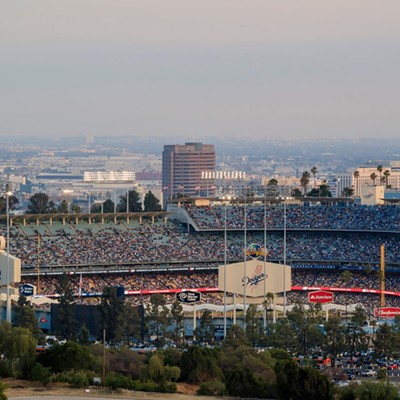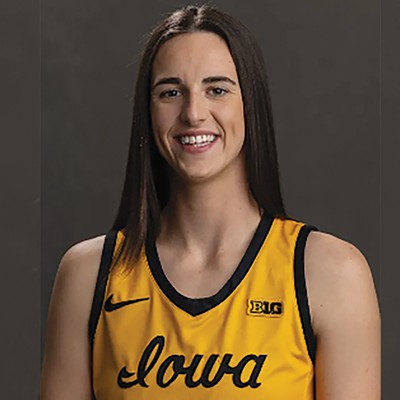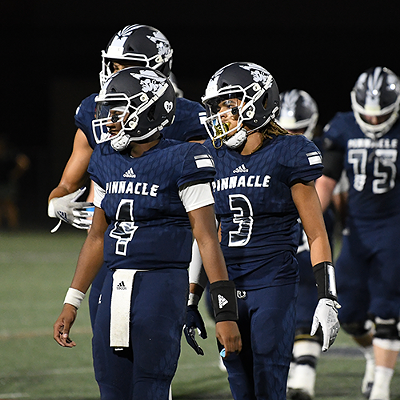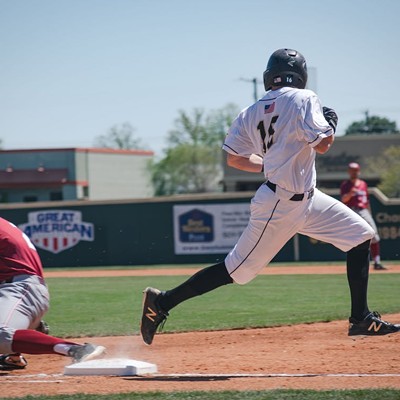Welcome to Sierra Vista, a town madly in love with its high-school athletic programs. It's a wacky place where out-of-town football games are broadcast on the radio and home girls' basketball games are televised. Where ostentation is the norm and excess is a virtue. Where fans giddily pay hundreds, if not thousands, of dollars to sit in a "luxury sky box" to watch the local football team lose week after week and where a booster club the size of a small town runs things with the sensibilities of Busby Berkeley and the budget of Berkeley, Calif.
The Colt Booster Club is a phenomenon not often seen in these parts, a juggernaut flush with cash and hell-bent on making every Buena High home game an event. Entertainment, fireworks and prize giveaways are everyday stuff down here, and they can all be traced to the Colt Booster Club, an organization with an astonishing 1,200 members and more money than they can spend. In just a few short years, the booster club has become a powerhouse that makes many outsiders green with envy and more than a few locals green with nausea.
SIERRA VISTA IS A GROWING CITY located either 70 or a million miles southeast of Tucson, depending on one's outlook. For decades, it was a sleepy little Army base town, existing symbiotically with adjacent Fort Huachuca. The fort had been used as an outpost in the battle against the Chiricahua and Mescalero Indians in the late 19th century. (Even then, the Army had its own way of doing things, seeing as how Fort Huachuca is at least a two- or three-hour drive today away from where the Indians did their business, with an entire mountain range thrown in between the two places, just for good measure.)
For years, Sierra Vista was just a place where people from outlying small towns would drive to get some fast food at one of the many outlets along Fry Boulevard, Sierra Vista's main drag. The street had so many fast-food places that it was often referred to as French Fry Boulevard. The first McDonald's used to give out bumper stickers proclaiming that it was the first McDonald's franchise in the entire world to have a drive-through window. This was a necessity because, at that time, military personnel were not allowed to enter off-base food establishments wearing their fatigues.
Today, Fort Huachuca is home to much of the Army's communications apparatus, and as bases are closed around the country and functions are consolidated, it continues to grow in size and strength. The small town continues to grow, as well, some say at an alarming rate. With a population of around 70,000, it is zooming past Yuma and Flagstaff and will soon become the largest city in Arizona outside the Phoenix and Tucson metropolitan areas.
The local prep sports teams have always been pretty good, but outside observers have often had a sense that something is missing. Jesse Gutierrez, who is an engineer for the City of Tucson, played football and competed in wrestling at Douglas High School, down by the Mexican border. "Buena always had good athletes," recalls Gutierrez, "but they didn't win nearly as much as they should have. We used to wonder if it was the Army thing or maybe the racial thing."
What he refers to is the transient nature of Army families and the schizo ethnic makeup of several Buena teams. Oftentimes there will be a great ballplayer on a Buena basketball team, for example, and then the next season, that kid will be in Germany because his mom or dad got transferred. Furthermore, for many years before the town's explosive growth began, the teams consisted of mostly black kids from the Army base, while most of the local students were white kids from nearby farms and ranches.
Whatever racial tension there was, was kept under control until the late 1970s when a black church from Chicago relocated in a place called Miracle Valley, which was little more than a gas station and a temple along the road between Sierra Vista and the mining town of Bisbee. Tensions between the church members and locals ran hot for months and finally culminated in a deadly shootout between church members and the Cochise County Sheriff's Department that left the son of the church pastor dead.
As the town has grown into a bustling city, those tensions have eased considerably. Local school officials claim that their diverse student population is a model for racial harmony.
But their football team still stinks.
"Yeah," laughs Colt Booster Club president Gary Greer, taking his time to find the right words, "they're struggling. But we're all working on that. If the football team ever starts winning, this entire town will explode right off the map."
Greer, a cockeyed optimist writ tall, sees nothing but blue skies ahead for his beloved Colts. Standing nearly 6-feet-4-inches, the one-time Tucsonan revels in his duties, shrugging at the mention of all that he has accomplished and being almost unable to wait for that which is to come.
Greer attended secondary school at Rincon High in Tucson and then joined his father's cabinetry firm. When his dad split with a longtime business partner and opened a business in Sierra Vista, he used to commute to work from Tucson every day. Back then, State Route 90 was one lane each way from I-10 all the way into Sierra Vista, so if you got stuck behind a Mexican produce truck, a wide-eyed winter tourist or an Army convoy rolling along with lights on and speed stuck in the mid-30s, it was a brutal two-hour trip each way.
Finally, Greer moved down to Sierra Vista and became active in the community. His wife was elected to the Palominas school board, covering an area south of Sierra Vista that includes Miracle Valley. Greer joined several civic organizations and then just gravitated toward the booster club. Oddly enough, unlike the stereotypical booster-club member, Greer has no children active in sports at Buena. He does have a 17-year-old son at the school, but his son enjoys water skiing and outdoor activities, but no organized sports.
Even more incredibly, neither of his top two assistants in the club, Tonja Christensen and Dick Kohnen, has any children at all.
"It's really great," says Greer. "Tonja and Dick often put in 20 to 25 hours a week each just on booster club activities and neither one has children. You've just got to be impressed by that."
When Greer started with the club, it was, he says, "a disjointed mess. There were all kinds of people with personal agendas. Some wanted to use the club to help promote their own kids, others wanted to use it as a business opportunity. We had some parents who wanted to have the athletes sell cosmetic products, for example, to boost sales of their at-home business. It was pretty bad."
It was even worse for harried local business people, who got hit up for donations from one team after another. "We had business owners who had come to dread the sight of young kids walking into their establishment. It would be the football players, then the cross-country runners, then the swimmers, then the basketball players. And it would go on all year 'round. And pretty soon these business people were like, 'Well, if I can't donate to all of them, I won't donate to any of them.' It was a bad situation."
What Greer did (and not without substantial opposition) was to organize all of the teams and programs under one umbrella and then hit the businesses up in an orderly (and lucrative) fashion. "Business owners were thrilled [by the new system]," says Greer. "They were happy to write one check for $250 or $500 rather than having to hand out $10 here and $20 there all year."
They also put together a discount card with lots of half-off and buy one, get one free offers from local merchants and restaurants that team members could sell for special projects, such as team banquets. "That way," Greer explains, "they could still do things for their teams without bothering the merchants." He pauses, then laughs. "This way, they can just bother their neighbors and relatives."
As the organization came together, some parents resisted. For many years, there had been separate booster groups for basketball, football, tennis and just about every other sport the school offered. Some had been moderately successful; some had failed completely. Some had been run by two or three parents who doggedly showed up to run snack bars at sporting events and to wash cars on Saturdays, while others consisted of a loose-knit group of team parents who were looking to give their kids an edge without having to spend to much time or effort in the process.
"It was pretty bad," agrees Colt Booster Club vice-president Jim Huff, who, among other things, oversees the money that flows into the coffers. "We've come a long way in a relatively short time, but I think that the best is still yet to come."
CERTAINLY, THERE HAS BEEN AN improvement in the athletic facilities. Near the junction of State Routes 90 and 92, at the east end of Fry Boulevard, lies the old football field. For decades, Buena High had sat right on the northwest corner of the intersection, but it was torn down recently and a gas station and some stores went up in its place.
The field, sadly now weed-covered and neglected, was left behind because when the citizens passed the big bond issue to build the new, ultra-modern Buena High School, there wasn't enough money for athletic fields. (The architectural and aesthetic wonder that is Buena High, with its massive gymnasium, mall-like food court and 40-foot-high clock with a face made from the old school's gym floor, could fill up a cover story by itself.) For the past few years, the football team had to play at the old field and baseball and softball teams had to play at city parks. Now a new football field with a high-tech scoreboard is finally in use and construction has begun on the on-campus baseball and softball complex.
Greer notes that they've already sold out the advertising space on the scoreboards for the as-yet unbuilt fields and have enough offers to advertise that they are considering building another scoreboard. At basketball and volleyball games, volunteer workers spend as much as an hour putting up banners purchased by local boosters. (The Arizona Interscholastic Association, which governs high-school sports in Arizona, mandates that all such banners must be put up immediately prior to the start of games and taken down afterward. Banners are not allowed to hang during school hours.) Last year, there were 62 banners hanging from the tops of the bleachers. The right to hang the banners cost each sponsor a cool $1,000.
"We take in a good amount of money," allows Greer, "but it all goes to good purposes."
Exactly how much money? According to club VP Huff, they have taken in just under $400,000 since July 1, 1999. They've probably also received as much as $100,000 in non-monetary donations, including a spectacular bronze sculpture of a colt that greets visitors to the football stadium. The sculpture was done by Bob Wick, a Sierra Vista artist who also co-owns the newspaper chain of which this publication is a part.
By comparison, Amphitheater High in Tucson, widely considered to be the best football program in Southern Arizona, raises about $7,000 a year. Salpointe Catholic might raise a bit more than that, but then they have the threat of eternal damnation with which to get boosters to open their checkbooks.
Individuals or businesses that join the booster club can buy memberships at different levels. A silver membership costs $250, gold goes for $500, platinum for $1,000 and diamond for $5,000. With membership comes certain privileges, including passes to all home games in every sport and special seating in a reserved section near the 50-yard line at football games. For an extra $500, you can treat yourself and seven of your buddies to a night in the luxury, air-conditioned sky box, adjacent to the press box, with catered food and unlimited sodas to drink. (It costs $1,000 to rent it on homecoming night, and it has been rented out every night this season.)
Greer is quick to point out that the boosters don't do things only for athletes. They donated $2,000 to the marching band, which will be appearing in the Rose Parade on New Year's Day. They also help the student council with their formal dances and help pay for the faculty's Christmas party.
ALL IS NOT SWEETNESS AND light, however. One parent, who asked not to be identified, bristles at the excesses. "It's gone crazy," says the woman, who had one daughter go through the basketball program and who has another one in school now participating in a sport she declined to identify. "It's completely out of control. They've got fireworks indoors and laser shows. It's ridiculous. You have to wonder how much of this is being done so the adults can show off. They keep trying to top each other.
"I go to games in Tucson where the only people in the gym are parents, cheerleaders, maybe a couple teachers and some of the kids' friends. I wonder if maybe they've got it right and we don't. I think for the most part that these [boosters'] hearts are in the right place, but we've reached a point where the spectacle is overwhelming the games themselves."
Another concern is about what happens when some people start wanting more bang for their buck. A persistent rumor that has spread through the coaching community in Southern Arizona is that the Colt Booster Club wants to have a say in hiring and firing coaches. Both Greer and Buena athletic director Jerry Winslow, who played basketball at Buena back in the 1970s, flatly deny that. Says Greer, "I'm sure there are people who would love for our group to have that power, but that's not what we're about. We take great steps to make sure that fringe elements like that don't get a toehold in our organization."
Mike Bunnell might disagree with that. For several years Bunnell has coached football, baseball and girls' basketball at Buena. This past summer he moved back to his native Iowa, but not before voicing his fears.
"These people have power and people with power like to exercise it," said Bunnell. "I'm not saying they're bad people; a lot of them are great. But some of them are very vocal about wanting Buena to dominate in everything. They're trying to position themselves to where they can have a hand in the hiring and especially the firing of coaches."
Bunnell himself was pressured into quitting as girls' basketball coach despite an outstanding won-lost record and respect among his peers. "I had a couple parents get mad about playing time for their kids during a preseason tournament, for cryin' out loud. When I tried to enforce the team rules, I got come down on hard. It might be all nice on the surface, but there is definitely an undercurrent."
Winslow denies that there is any attempt by the boosters to meddle in personnel matters. "I have some parents serve on committees for hiring so that that part of the community can have a voice. But as for firing, never. The boosters never act alone on the hiring or firing of coaches. Never."
Except ...
Early last spring, two men made the drive up to Tucson from Sierra Vista. They pulled onto the campus at Amphitheater High School, parked, then walked into the football weight room, a dank, windowless mausoleum under the home bleachers at the Amphi football stadium. They had made the trip to seek out Vern Friedli, the winningest prep football coach in Southern Arizona history and pretty much a living legend.
The two men presented themselves as members of the Buena Colt Booster Club and they had come to make Friedli an offer. Officially retired as a teacher, Friedli, disgustingly fit and outrageously healthy for a man in his 60s, was preparing for his 25th year as coach at Amphi, a season in which he would almost certainly break the Arizona state high-school record for most victories by a coach at one school.
The Amphi weight room is best described by whatever the antonym of "state-of-the-art" might be. There are only free-weights and, even then, not a whole lot of those. The weight benches are old and worn, with large bites taken out of what once was cheesy-looking glittery foam padding. Loud music blasts from an ancient boom box in the corner--rap one day, alternative the next, but never easy listening.
In the opposite corner from the music is Friedli's desk, unassuming, cluttered but never messy. Friedli sits behind the desk for hours at a time, conversing with a steady stream of visitors, including many people who played for him over the past quarter-century and just want to stop in and say hello. He'll talk to almost anybody about almost anything. But he also has the habit of stopping in mid-sentence to join in the rooting ritual when a football player is attempting to achieve a new personal record in one of the three or four weight-lifting disciplines that Friedli teaches.
On this day, the two men sat across from Friedli and calmly laid out their offer. The Colt Booster Club was willing to see to it that he received an annual salary of $50,000 if he would coach the Buena football team. He wouldn't have to teach a class. He wouldn't even have to live in Sierra Vista if he didn't want to. All he would have to do is lend his magic to the perennially godawful Colt football team.
This practice is fairly common in other parts of the country, most notably in Ohio, Florida and Texas. In the latter, some coaches have salaries approaching six figures and if they have to teach at all, it's just a couple of weight-training classes to make sure that their "hosses" get their work in.
(A few years back, Phoenix-area coach Jesse Parker, best known for running up scores on hapless opponents and for racist tirades on the sidelines, left his cushy position at mega-school Mesa Mountain View, where a population of 4,000 students in only three grades pretty much guarantees athletic success, to take a high-paying job in Texas. While there, he suddenly had to deal with kids from the lower socioeconomic levels and--gasp!--black kids, as well. After compiling a losing record over several years, Parker slinked back to Arizona a couple of years ago and got a job at Gilbert High. His Tigers opened the season picked to win the Class 5A state title, but they've already lost three games this season and are in danger of not even making the playoffs.)
Friedli listened to the offer from the two boosters and told them he'd think it over. When asked about it later, he laughs, "Hey, that's about $48,000 more than I make here [at Amphi]. But it's not about the money. They've got great facilities down there and some real good athletes, too. I've always considered Buena to be a sleeping giant. But I'm an Amphi guy."
Then he adds, "One of my friends suggested that at this stage of my career, I might really enjoy a challenge." He looks around the weight room at the undersized and small-in-numbers athletes that are the staple of the championship Amphi program and says, "Hey, I've got a challenge here every year."
Greer says that he has "heard that story [about the offer]," but he says he had nothing to do with it. Athletic director Winslow says that he had "an informal discussion" with Friedli over the phone, but that was that. Buena eventually hired Jim Yencarelli, who had coached at several Southern Arizona schools before heading to California for a few years. The Colts opened this season with a win over Class 4A Douglas, then proceeded to lose seven straight.
The boosters recently had their annual bash, a tropical blowout complete with a mechanical surfboard and coconut bowling. Greer had been asked whether he would run for president again and he said he wasn't sure. But when he got up to give a few remarks, he was drowned out by shouts from the floor of "Four more years! Four more years!"
He smiles at the mention. "I'm grateful for their support. I think eventually I'd like to hand it over to someone else. I just want them to maintain the momentum. Honestly, I think we've just scratched the surface here. We've got some wild ideas for the future."














